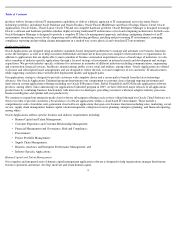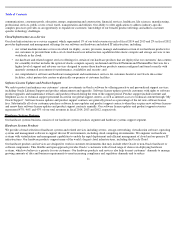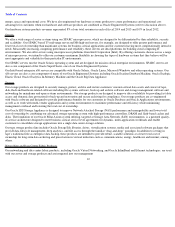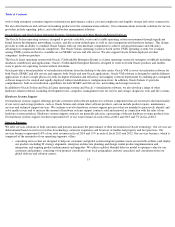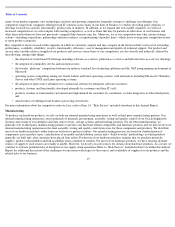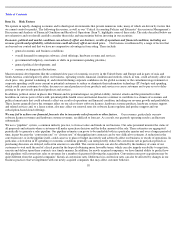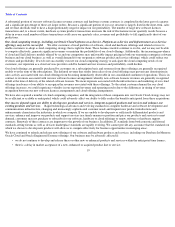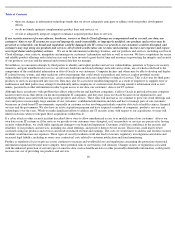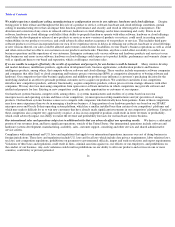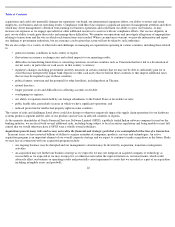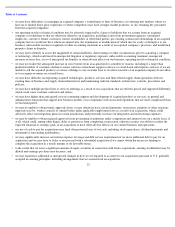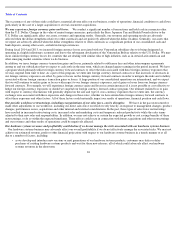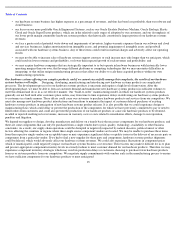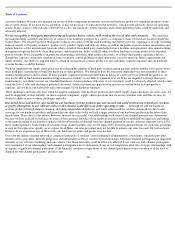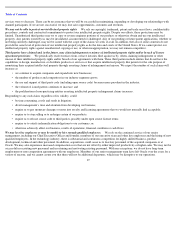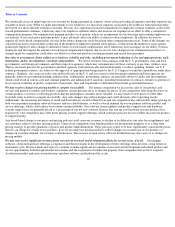Oracle 2013 Annual Report Download - page 22
Download and view the complete annual report
Please find page 22 of the 2013 Oracle annual report below. You can navigate through the pages in the report by either clicking on the pages listed below, or by using the keyword search tool below to find specific information within the annual report.
Table of Contents
Item 1A. Risk Factors
We operate in rapidly changing economic and technological environments that present numerous risks, many of which are driven by factors that
we cannot control or predict. The following discussion, as well as our “Critical Accounting Policies and Estimates” discussion in Management’s
Discussion and Analysis of Financial Condition and Results of Operations (Item 7), highlights some of these risks. The risks described below are
not exhaustive and you should carefully consider these risks and uncertainties before investing in our securities.
Economic, political and market conditions can adversely affect our business, results of operations and financial condition, including our
revenue growth and profitability, which in turn could adversely affect our stock price. Our business is influenced by a range of factors that
are beyond our control and that we have no comparative advantage in forecasting. These include:
Macroeconomic developments like the continued slow pace of economic recovery in the United States and Europe and in parts of Asia and
South America could negatively affect our business, operating results, financial condition and outlook, which, in turn, could adversely affect our
stock price. Any general weakening of, and related declining corporate confidence in, the global economy or the curtailment in government or
corporate spending could cause current or potential customers to reduce or eliminate their information technology (IT) budgets and spending,
which could cause customers to delay, decrease or cancel purchases of our products and services or cause customers not to pay us or to delay
paying us for previously purchased products and services.
In addition, political unrest in places like Ukraine and its potential impact on global stability, terrorist attacks and the potential for other
hostilities in various parts of the world, potential public health crises and natural disasters continue to contribute to a climate of economic and
political uncertainty that could adversely affect our results of operations and financial condition, including our revenue growth and profitability.
These factors generally have the strongest effect on our sales of new software licenses, hardware systems products, hardware systems support
and related services and, to a lesser extent, also may affect our renewal rates for software license updates and product support and our
subscription-based cloud offerings.
We may fail to achieve our financial forecasts due to inaccurate sales forecasts or other factors. Our revenues, particularly our new
software licenses revenues and hardware systems revenues, are difficult to forecast. As a result, our quarterly operating results can fluctuate
substantially.
We use a “pipeline” system, a common industry practice, to forecast sales and trends in our business. Our sales personnel monitor the status of
all proposals and estimate when a customer will make a purchase decision and the dollar amount of the sale. These estimates are aggregated
periodically to generate a sales pipeline. Our pipeline estimates can prove to be unreliable both in a particular quarter and over a longer period of
time, in part because the “conversion rate” or “closure rate” of the pipeline into contracts can be very difficult to estimate. A reduction in the
conversion rate, or in the pipeline itself, could cause us to plan or budget incorrectly and adversely affect our business or results of operations. In
particular, a slowdown in IT spending or economic conditions generally can unexpectedly reduce the conversion rate in particular periods as
purchasing decisions are delayed, reduced in amount or cancelled. The conversion rate can also be affected by the tendency of some of our
customers to wait until the end of a fiscal period in the hope of obtaining more favorable terms, which can also impede our ability to negotiate,
execute and deliver upon these contracts in a timely manner. In addition, for newly acquired companies, we have limited ability to predict how
their pipelines will convert into sales or revenues for a number of quarters following the acquisition. Conversion rates post-acquisition may be
quite different from the acquired companies’ historical conversion rates. Differences in conversion rates can also be affected by changes in our
business practices that we implement with our newly acquired companies that may affect customer behavior.
18
•
general economic and business conditions;
•
overall demand for enterprise software, cloud offerings, hardware systems and services;
•
governmental budgetary constraints or shifts in government spending priorities;
•
general political developments; and
•
currency exchange rate fluctuations.



